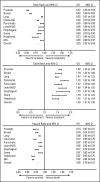Marital status and survival in patients with cancer
- PMID: 24062405
- PMCID: PMC4878087
- DOI: 10.1200/JCO.2013.49.6489
Marital status and survival in patients with cancer
Abstract
Purpose: To examine the impact of marital status on stage at diagnosis, use of definitive therapy, and cancer-specific mortality among each of the 10 leading causes of cancer-related death in the United States.
Methods: We used the Surveillance, Epidemiology and End Results program to identify 1,260,898 patients diagnosed in 2004 through 2008 with lung, colorectal, breast, pancreatic, prostate, liver/intrahepatic bile duct, non-Hodgkin lymphoma, head/neck, ovarian, or esophageal cancer. We used multivariable logistic and Cox regression to analyze the 734,889 patients who had clinical and follow-up information available.
Results: Married patients were less likely to present with metastatic disease (adjusted odds ratio [OR], 0.83; 95% CI, 0.82 to 0.84; P < .001), more likely to receive definitive therapy (adjusted OR, 1.53; 95% CI, 1.51 to 1.56; P < .001), and less likely to die as a result of their cancer after adjusting for demographics, stage, and treatment (adjusted hazard ratio, 0.80; 95% CI, 0.79 to 0.81; P < .001) than unmarried patients. These associations remained significant when each individual cancer was analyzed (P < .05 for all end points for each malignancy). The benefit associated with marriage was greater in males than females for all outcome measures analyzed (P < .001 in all cases). For prostate, breast, colorectal, esophageal, and head/neck cancers, the survival benefit associated with marriage was larger than the published survival benefit of chemotherapy.
Conclusion: Even after adjusting for known confounders, unmarried patients are at significantly higher risk of presentation with metastatic cancer, undertreatment, and death resulting from their cancer. This study highlights the potentially significant impact that social support can have on cancer detection, treatment, and survival.
Conflict of interest statement
Authors' disclosures of potential conflicts of interest and author contributions are found at the end of this article.
Figures

Comment in
-
Marriage is as protective as chemotherapy in cancer care.J Clin Oncol. 2013 Nov 1;31(31):3852-3. doi: 10.1200/JCO.2013.51.5080. Epub 2013 Sep 23. J Clin Oncol. 2013. PMID: 24062396 No abstract available.
-
Reply to M.G. Bare et al.J Clin Oncol. 2014 Jul 10;32(20):2184. doi: 10.1200/JCO.2014.55.6688. Epub 2014 Jun 2. J Clin Oncol. 2014. PMID: 24888805 No abstract available.
-
Omission of sexual and gender minority patients.J Clin Oncol. 2014 Jul 10;32(20):2182-3. doi: 10.1200/JCO.2014.55.6126. Epub 2014 Jun 2. J Clin Oncol. 2014. PMID: 24888807 No abstract available.
-
Re: marital status and survival in patients with cancer.J Urol. 2014 Jun;191(6):1783-4. doi: 10.1016/j.juro.2014.03.064. Epub 2014 Mar 20. J Urol. 2014. PMID: 25280281 No abstract available.
Similar articles
-
Assessment of Modifiable Factors for the Association of Marital Status With Cancer-Specific Survival.JAMA Netw Open. 2021 May 3;4(5):e2111813. doi: 10.1001/jamanetworkopen.2021.11813. JAMA Netw Open. 2021. PMID: 34047792 Free PMC article.
-
Marital status and head and neck cancer outcomes.Cancer. 2015 Apr 15;121(8):1273-8. doi: 10.1002/cncr.29171. Epub 2014 Dec 18. Cancer. 2015. PMID: 25524565
-
The effect of marital status on breast cancer-related outcomes in women under 65: A SEER database analysis.Breast. 2017 Apr;32:13-17. doi: 10.1016/j.breast.2016.12.008. Epub 2016 Dec 22. Breast. 2017. PMID: 28012410
-
The effect of marriage on stage at diagnosis and survival in women with cervical cancer.Psychooncology. 2017 May;26(5):704-710. doi: 10.1002/pon.4070. Epub 2016 Jan 26. Psychooncology. 2017. PMID: 26810012
-
Treatment disparities for disabled medicare beneficiaries with stage I non-small cell lung cancer.Arch Phys Med Rehabil. 2008 Apr;89(4):595-601. doi: 10.1016/j.apmr.2007.09.042. Arch Phys Med Rehabil. 2008. PMID: 18373987 Review.
Cited by
-
A novel nomogram and risk classification system predicting the overall survival of patients with papillary renal cell carcinoma after nephrectomy: A population-based study.Front Public Health. 2022 Oct 5;10:989566. doi: 10.3389/fpubh.2022.989566. eCollection 2022. Front Public Health. 2022. PMID: 36276376 Free PMC article. Clinical Trial.
-
Prognostic Factors and Nomograms for Overall and Cancer-Specific Survival of Patients with Uveal Melanoma without Metastases: A SEER Analysis of 4119 Cases.J Ophthalmol. 2022 Sep 14;2022:1874336. doi: 10.1155/2022/1874336. eCollection 2022. J Ophthalmol. 2022. PMID: 36157683 Free PMC article.
-
Marital status and survival of patients with colorectal signet ring cell carcinoma: a population-based study.Sci Rep. 2020 Oct 21;10(1):17881. doi: 10.1038/s41598-020-74720-7. Sci Rep. 2020. PMID: 33087758 Free PMC article.
-
Evolution of transmissible cancers: An adaptive, plastic strategy of selfish genetic elements?iScience. 2024 Aug 20;27(9):110740. doi: 10.1016/j.isci.2024.110740. eCollection 2024 Sep 20. iScience. 2024. PMID: 39286496 Free PMC article. Review.
-
A visualized dynamic prediction model for survival of patients with geriatric thyroid cancer: A population-based study.Front Endocrinol (Lausanne). 2022 Dec 9;13:1038041. doi: 10.3389/fendo.2022.1038041. eCollection 2022. Front Endocrinol (Lausanne). 2022. PMID: 36568078 Free PMC article.
References
-
- Pew Research Center. Social and demographic trends. http://www.pewsocialtrends.org.
-
- Fosså SD, Cvancarova M, Chen L, et al. Adverse prognostic factors for testicular cancer-specific survival: A population-based study of 27,948 patients. J Clin Oncol. 2011;29:963–970. - PubMed
-
- Rendall MS, Weden MM, Favreault MM, et al. The protective effect of marriage for survival: A review and update. Demography. 2011;48:481–506. - PubMed
-
- Sammon JD, Morgan M, Djahangirian O, et al. Marital status: A gender-independent risk factor for poorer survival after radical cystectomy. BJU Int. 2012;110:1301–1309. - PubMed
-
- Wang L, Wilson SE, Stewart DB, et al. Marital status and colon cancer outcomes in US Surveillance, Epidemiology and End Results registries: Does marriage affect cancer survival by gender and stage? Cancer Epidemiol. 2011;35:417–422. - PubMed
Publication types
MeSH terms
Grants and funding
LinkOut - more resources
Full Text Sources
Other Literature Sources

